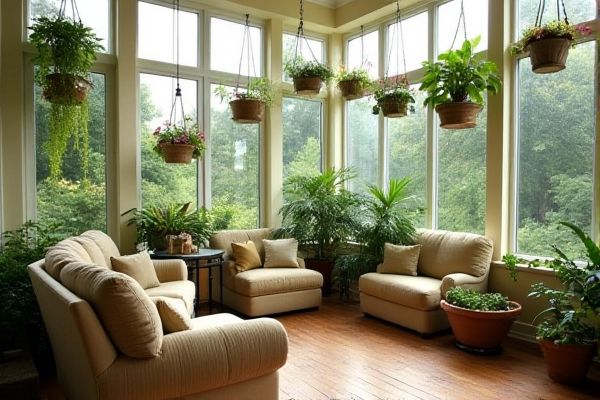
Hanging planters save floor space and create a vertical garden effect, ideal for small sunrooms with limited room, while floor planters provide stability and allow for larger plants, enhancing your sunroom's greenery at eye level. Discover which option suits your sunroom setup and how to maximize plant health by reading the rest of the article.
Table of Comparison
| Feature | Hanging Planters | Floor Planters |
|---|---|---|
| Space Efficiency | Maximizes vertical space, ideal for small sunrooms | Requires floor space, can limit movement |
| Light Exposure | Can be positioned for optimal sunlight | May receive uneven light depending on placement |
| Plant Variety | Best for trailing or lightweight plants | Supports larger and heavier plants |
| Maintenance | Easier watering but harder access for some | Simple access for watering and care |
| Decor Impact | Adds vertical visual interest, saves floor clutter | Creates stable, grounded focal points |
| Installation | Requires secure ceiling mounts | Easy to move, no installation needed |
Introduction to Sunroom Planters
Sunroom planters enhance your indoor garden by optimizing space and light exposure. Hanging planters save floor area and create a vertical green display, while floor planters offer stability for larger plants and diverse arrangements. Choosing the right option depends on your sunroom's size, light availability, and plant types.
What Are Hanging Planters?
Hanging planters are containers suspended from ceilings or walls, ideal for maximizing space in your sunroom while adding vertical greenery. These planters provide excellent air circulation and can create a visually appealing focal point by displaying trailing or cascading plants. Choosing hanging planters over floor planters helps keep your sunroom floor clear, making it easier to clean and enhancing overall room aesthetics.
What Are Floor Planters?
Floor planters are containers designed to hold plants directly on the ground, providing stability and accommodating larger plants or trees in a sunroom. Unlike hanging planters, floor planters often come in various sizes and materials like ceramic, terracotta, or metal, making them ideal for creating a natural, grounded aesthetic. Their substantial size supports deeper root systems, enhancing plant health and growth in sunroom environments.
Space Optimization in Sunrooms
Hanging planters maximize vertical space in sunrooms, allowing for more greenery without occupying valuable floor area, ideal for small or narrow sunrooms. Floor planters provide stable housing for larger plants but consume significant floor space, potentially limiting movement and furniture placement. Efficient sunroom design often combines hanging planters with compact floor planters to optimize spatial use while enhancing natural light exposure for plants.
Aesthetic Appeal: Hanging vs Floor Planters
Hanging planters in a sunroom create a dynamic vertical garden effect, enhancing visual interest and freeing up floor space for other decor elements. Floor planters provide a grounded, natural feel with larger plants that serve as focal points, adding depth and texture to the room. Choosing between hanging and floor planters depends on the desired aesthetic balance, with hanging options offering airiness and floor planters contributing substantial greenery presence.
Sunlight Exposure and Plant Health
Hanging planters in a sunroom maximize sunlight exposure by suspending plants closer to windows or skylights, ensuring even light distribution essential for photosynthesis and healthy growth. Floor planters may receive uneven sunlight due to shadows cast by furniture or other plants, which can impact your plant's development and overall health. Choosing hanging planters helps optimize natural light access, supporting stronger stems, vibrant foliage, and increased flowering in your sunroom garden.
Maintenance and Accessibility
Hanging planters in a sunroom require regular watering and pruning due to their elevated position, which can make maintenance slightly more challenging but helps save floor space. Floor planters offer easier accessibility for routine care, allowing gardeners to water, fertilize, and inspect plants without the need for ladders or stools. Both types of planters benefit from proper drainage and sunlight exposure, but floor planters tend to accommodate larger plants, reducing the frequency of repotting compared to hanging options.
Suitable Plant Types for Each Planter
Hanging planters in a sunroom are ideal for trailing plants like pothos, spider plants, and string of pearls, as they maximize vertical space and allow vines to cascade naturally. Floor planters suit larger, upright plants such as fiddle leaf figs, snake plants, and rubber trees, providing stability and room for extensive root growth. Choosing the right planter based on plant type ensures optimal sunlight exposure and healthy development in your sunroom environment.
Cost and Installation Considerations
Hanging planters for your sunroom often have lower initial costs and require minimal installation, typically needing just hooks or brackets. Floor planters can vary widely in price depending on size and material, and may require more space and effort to position correctly. Choosing between them depends on your budget and willingness to manage installation complexity.
Choosing the Best Planter for Your Sunroom
Hanging planters maximize vertical space in your sunroom, ideal for trailing plants and adding greenery without cluttering the floor. Floor planters offer more stability and accommodate larger plants, enhancing the room's natural ambiance with substantial foliage. Your choice depends on the size of your sunroom, the types of plants you want, and the available space for sunlight exposure.
 homyna.com
homyna.com